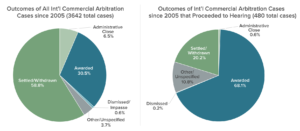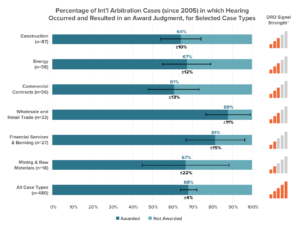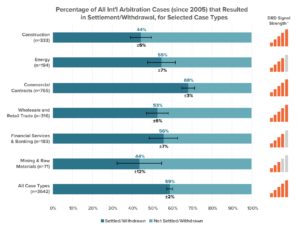In this continuing series of blog posts, we have been using Dispute Resolution Data (DRD)’s growing repository of international arbitration case data to analyze the extent to which such cases reach various outcomes, whether it be an award being rendered, administrative closure, dismissal, impasse, or settlement/withdrawal (which we treat as a single, distinct outcome). Our first blog post demonstrated that when looking at an aggregate of DRD’s international commercial arbitration case data (which, as of November 2018, includes approximately 4,000 arbitration and mediation cases, dating back to 2005), the most frequently observed outcome is settlement/withdrawal, which is often reached within a year of the claim date and also prior to any counter-claim, preliminary hearing, or hearing on the merits. Our follow-up blog posts demonstrated that the margin of error (MOE) associated with such results is largely dependent on the size of the sample used to estimate the proportion of the “population” of all such cases known to have occurred. We also introduced our proprietary “Signal Strength” metric, a quick visual indicator of the degree of confidence that the statistical estimate based on DRD’s data sample is closely representative of all cases meeting the same criteria; put simply, the greater of the number of cases used as a data sample, the smaller the MOE (and correspondingly, the higher the “Signal Strength”).
Here, we examine how the spectrum of case outcomes potentially shifts when the case does not settle quickly and instead proceeds to a hearing on the merits. Based on the current sample of 3,642 international commercial arbitration cases in DRD’s database, we estimate that approximately 13% of such cases proceed to a hearing. Because of the relatively large size of the data sample, this estimate has a low margin of error (±1%) and a high “Signal Strength” (5 out of 5), as depicted in Figure 1:
Figure 1. Percentage of international commercial arbitration cases (since 2005) that proceed to a hearing on the merits, based on all such case data currently stored in the DRD database (3,642 cases as of November 2018). In this and all applicable subsequent figures, the MOE (margin of error, indicated by error bars) has been computed at the 95% confidence level. The “Signal Strength,” whose computational details are proprietary to DRD, provides a quick visual indicator of the degree of confidence that the reported statistic lies within an acceptably narrow MOE (at most ±5%).
Figure 2 depicts the distribution of case outcomes from an aggregate view of all international arbitration cases, compared side-by-side with the corresponding distribution of only those cases that proceed to a hearing, which applies to a total of 480 cases. When taking all 3,642 international commercial arbitration cases into account, a clear majority (approximately 59%) of cases result in settlement/withdrawal, with comparatively fewer cases resulting in an award and other outcomes, which is consistent with our previously reported results. However, when we limit the analysis to include only those cases that have proceeded to a hearing, the distribution of outcomes clearly shifts towards a sizeable majority of cases (approximately 68%) that result in an award judgment, with a correspondingly small proportion of cases (approximately 20%) reaching settlement/withdrawal:
Figure 2. Outcomes of international commercial arbitration cases (since 2005) in the DRD database, with comparison between all such cases (left) and only those cases that proceed to a hearing on the merits (right).
Although the sample size is reduced when we focus only on those cases in which a hearing occurred, the sample of 480 applicable cases is nonetheless sufficiently large enough to produce a relatively narrow margin of error (±4%) and high “Signal Strength” (5 out of 5), as depicted in Figure 3:
Figure 3. Percentage of international commercial arbitration cases (since 2005) that result in an award judgment, based only on those cases that proceed to a hearing on the merits, and as estimated from a sample size of 480 such cases.
Based on this data sample, we can be reasonably confident that the chances of an award judgment being rendered are relatively high (and likely to be close to the reported proportion of 68%) across the “population” of all known international commercial arbitration cases that proceed to a hearing.
However, parties that are exploring international commercial arbitration as a dispute resolution mechanism are probably interested mainly in those cases of a particular case type. From Figure 4, we see that when we break down the cases for which a hearing has occurred by case type, the sample sizes are necessarily smaller, which results in a wider MOE and a reduced “Signal Strength.” Even so, the estimated proportion of cases that result in an award judgment (again, only for those cases that have proceeded to a hearing) is consistently very high—more than 60% for all case types shown. Further, even when accounting for the wider MOE, one can still be confident that even the minimum proportion of cases that result in an award (corresponding to the left endpoint of each error bar in Figure 4) will approach or exceed the 50% mark:
Figure 4. Estimated proportion of international commercial arbitration cases (since 2005) that proceed to a hearing and ultimately result in an award judgment, for six selected case types (with sample sizes indicated in parentheses for each case type). For comparison, the last subfigure (itself a repeat of Figure 3 above) shows the corresponding estimated proportion when all case types are considered.
For comparison, Figure 5 provides corresponding results (for the same set of six selected case types) that depict how the estimated proportion of cases that reach settlement/withdrawal (regardless of whether a hearing has occurred) varies by case type:
Figure 5. Estimated proportion of international commercial arbitration cases (since 2005) that result in settlement/withdrawal, for six selected case types (with sample size indicated in parentheses for each case type). The last subfigure indicates the corresponding estimated proportion when all case types are considered.
Our analysis suggests that for parties considering international commercial arbitration as a dispute resolution mechanism, the chances of reaching settlement are markedly lower once the case proceeds to a hearing, since the likely outcome of the hearing will be the rendering of an award judgment. This has potential implications from a cost and speed standpoint; if settlement cannot be reached early in the arbitration timeline, the expenses associated with preparing for and conducting the eventual hearing will inevitably grow, since the protracted case duration will result in higher overall attorney fees and other costs. Fortunately (at least, for the parties seeking dispute resolution), and as we have shown previously, settlement usually is reached quickly—often within one calendar year of the initial claim date—and as we have demonstrated herein, the procession to a hearing only occurs in a small fraction (between 12% and 14%) of all international commercial cases.
These results continue to support the notion that arbitration is a potentially effective mechanism for reaching settlement. In our future blog posts, we will more deeply explore and extract insights from the more than 200,000 data points in DRD’s growing repository. For example, we plan to examine how international commercial arbitration case outcomes are possibly affected by such parameters as the region in which the case occurred, the magnitude of the claim amount, and other criteria that contribute to a finer-grained analysis.
________________________
To make sure you do not miss out on regular updates from the Kluwer Arbitration Blog, please subscribe here. To submit a proposal for a blog post, please consult our Editorial Guidelines.








